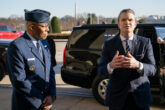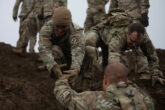October 04, 2022
How to Improve Your Pickup Aviation Advising Game
The United States failed in its attempts to build air forces in Iraq and Afghanistan for numerous reasons. Chief among these was policymakers’ excessive ambition: they failed to consider what the US military services could plausibly deliver and what Iraqi and Afghan air forces could realistically absorb. The provision of ill-suited F-16s to the Iraqis, for example, and UH-60s to the Afghans led to a loss of lives, time, and money. And the US military utilized aviation advisors in an ineffective ad hoc approach that we can best describe as an amateur pickup game—random, inexperienced personnel working together briefly before rotating out.
Imagine walking into a park to see a soccer game. One team is made of pickup players wearing a hodgepodge of uniforms and confused by the game and each other. The team members communicate poorly, resulting in confusion and fouls. Slowly, they learn and improve, but just as things start to go well, they step off the field and walk out of the park. Replacements appear from seemingly every direction to fill the vacancies on the soccer field. With the rookies, the team’s performance slips back to where it started. The new players make the same mistakes and learn the same hard lessons as their predecessors.
The best solution for a successful large-scale air advising mission is for the Air Force to organize, train, and equip a standing advisor wing with regionally aligned squadrons that build partnerships and capabilities in support of combatant command priorities.
This example illustrates the shortcomings of aviation advising in Iraq and Afghanistan. There, aviation advisor missions were staffed with a collection of individual augmentees drawn from the joint and coalition forces based on rank and duty qualifications, but inexperienced in the advising mission. And with few exceptions, aviation advisors rarely returned to the mission after leaving the theater. In effect, advisor missions were forced to continually climb the learning curve only to slide back down when advisors departed en masse with their hard-won knowledge and experience. This approach was ill-suited for a mission that required contextualized learning over the long term.
Read the full story from Modern War Institute.
More from CNAS
-
Hegseth Brings the Culture War to Combat
The fundamental challenge of military leadership lies in creating cohesive teams that can work together in an environment of mortal risk and, when called upon to do so, use le...
By Dr. Jason Dempsey
-
Hegseth Says Trump Boosted Military Recruiting. It’s Been Improving for over a Year
Defense Secretary Pete Hegseth says military recruiting has shot up since the Trump administration's return. In fact, it's been improving for at least a year, with big jumps i...
By Taren Sylvester
-
Pete Hegseth’s Views About Women and Military Standards
In recent weeks, Hegseth walked back comments made while promoting his book, where he said women did not belong in ground combat units. Without citing specific examples, he co...
By Katherine L. Kuzminski
-
Sharper: Trump's First 100 Days
Donald Trump takes office in a complex and volatile global environment. Rising tensions with China, the continued war in Ukraine, and instability in the Middle East all pose s...
By Charles Horn




